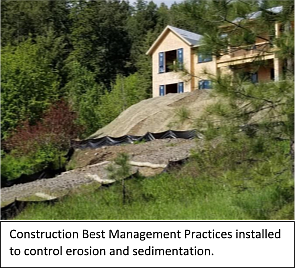Our Gem: Construction ahead: Keep the lake clear
Everywhere you look, new houses are going up, highways are full of work zones, and lots are being cleared for new businesses. Construction inevitably changes our community, but it can also have a negative impact on our waterways. If you live near a lake, river, stream, or stormwater system, which includes almost everyone, you can minimize your environmental impact while complying with local regulations.
Construction activities are one of the biggest sources of water pollution. The building process usually requires removing plants and soil, compacting soil and creating impervious surfaces that prevent precipitation from recharging our aquifer, our area’s principal source of drinking water. Aquifer depletion can also lead to lower lake levels. These activities can have negative effects on water quality. When existing vegetation is cleared, bare soil is exposed that can be easily washed into our stormwater systems, lakes, rivers, and streams. Excess sediment in water is a major pollutant that clouds the water, inhibits plants from producing oxygen, smothers fish spawning beds, and promotes algae blooms. Sediment is the most common water quality problem in Idaho and it often contains excess phosphorus and nitrogen, nutrients that can be deadly to the watershed ecosystem.
While construction is necessary to meet the needs of our growing population, there are ways to minimize erosion and keep our water clear and clean. If you plan to build or disturb ground on your property, call your city building services or county development department for guidance through the site disturbance permit process. They may deem your project to be low risk for sedimentation concerns and require nothing. For projects that are classified as moderate to high risk, a stormwater and erosion control plan must be developed. The site disturbance permit may require adoption of Best Management Practices (BMPs) prior to clearing vegetation. Those who fail to obtain a permit may find that a code violation has been placed on their property. Waterfront property owners have a special responsibility to take care of the waterbody they enjoy and should adhere to the Kootenai County ‘25 Foot Shoreline No Disturbance Zone’. Guidance for property owners and what to do if you see a violation may be found at the County website: https://www.kcgov.us/ArchiveCenter/ViewFile/Item/408.
BMPs are practices that control, prevent, or minimize water pollution from erosion and sedimentation. These may simply preserve as much vegetation onsite as possible with a phased construction schedule. BMPs are designed to minimize erosion, to slow runoff and to filter sediment. You may recognize erosion control as the green hydroseeding mixture sprayed on hillsides and sediment control with the black fabric silt fencing surrounding job sites. When properly installed and maintained, BMPs limit the amount of sediment leaving a construction zone.
Property owners can use the LakeASyst manual, available at www.uidaho.edu/ourgem, to assess erosion risk on your property. Make sure your contractor has a current Stormwater and Erosion Education Program (SEEP) certification. SEEP is a local organization teaching individuals in the construction and land development industries the fundamentals of erosion prevention and sediment control practices. Participants take a two-day course involving classroom and field work as well as an exam to earn a certificate in erosion and sediment control (www.PanhandleSEEP.org).
With construction season underway, it is important to manage sediment onsite, reduce runoff, and limit the impacts of construction on our beautiful lakes and rivers.
• • •
The Our Gem Coeur d’Alene Lake Collaborative is a team of professionals working to protect our local water resources. Participating entities include University of Idaho Community Water Resource Center, Coeur d’Alene Tribe Lake Management Department, Idaho Department of Environmental Quality, Kootenai Environmental Alliance, the CDA Chamber of Commerce, and CDA 2030.

